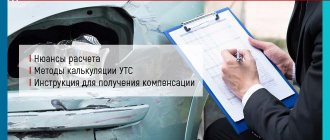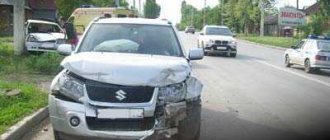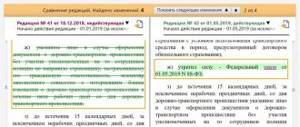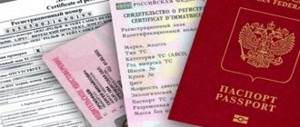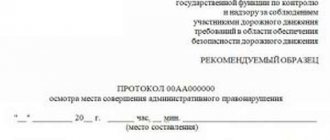Used cars can have different values. Sometimes a good used vehicle in almost perfect condition costs much less than a new one. The catch lies in the fact that the car was involved in an accident, and then was restored. Even after a small accident, the car loses value , and selling it becomes much more difficult. Compensation for loss of marketable value (LCV) in insurance is a payment after an accident, which allows the driver to restore the damaged balance. Read on to learn how to obtain a vehicle insurance policy under compulsory motor liability insurance in 2021.
An advantageous offer from the partners of our portal - Terem Loan! Apply for a loan in the amount of up to 30 thousand rubles for a period of up to 30 days.
100% approval!
Get money
When does the marketable value of a car lose under compulsory motor liability insurance?
Attention
Loss of marketable value under compulsory motor liability insurance is the difference between the price of the car before the accident and after restoration, with the elimination of damage received in the accident. Any, even the most high-quality repair is not able to eliminate defects without leaving a trace, and this will affect the value of the car in case of sale. That is why it is very important for the car owner to receive appropriate compensation from the insurance company.
According to Art. 7.1 of the methodological recommendations for forensic experts carrying out work to examine vehicles in order to determine the amount of damage, adopted in July 2013, payment of compensation for loss of marketable value of a vehicle under compulsory motor liability insurance in 2021 is possible only if the following conditions are met:
Attention! If you have any questions, you can chat for free with a lawyer at the bottom of the screen or call Moscow; Saint Petersburg; Free call for all of Russia.
- a foreign-made car should not be older than five years, a domestic one - three;
- machine wear level – up to thirty-five percent;
- compensation is paid if the accident was the first for the car;
- the car owner should not be at fault for the accident;
- compensation for vehicle insurance together with other insurance payments cannot exceed the maximum possible insured amount;
- the victim must have a valid MTPL auto insurance contract;
Please note:
Compensation under CASCO is subject to payment unless a contrary condition is specified in the contract.
If the situation does not meet the above criteria, TCB will not be compensated.
How to recover the lost marketable value of a vehicle?
The vehicle's technical value is a conditional value. It is characterized by a decrease in the value of a car after being damaged in an accident. According to the basic principles of insurance, insurance companies (insurance companies) must necessarily return the amount of the insurance policy to the insured persons, but, as practice shows, this almost never happens. And the blame here lies, first of all, on the illiteracy of drivers in legal matters and the capabilities of insurers.
TTC is always accrued when the vehicle receives damage that requires repairs or replacement of spare parts. Everyone knows that any detail of a vehicle affects its user and technical characteristics. And accordingly, in case of repairs, they are automatically reduced. In turn, the size of the training facility is determined after an independent examination.
In practice, it has been proven that many claims to the insurance company regarding compensation for technical assistance often end in refusals. And all because insurers refer to Article 6, paragraph 2 of the law on compulsory motor liability insurance, thereby converting the market value of the car into lost profits. This position is considered illegal and leads to a direct violation of human rights to receive full compensation for damage to the car resulting from an accident. UTS is legally considered to be actual damage received, and therefore is subject to payment under any of the policies, both CASCO and OSAGO.
In addition, the TTC is not always calculated by specialists. In this regard, in order to receive compensation payments for this indicator, you must meet the following requirements:
- The vehicle must not have been involved in accidents in the past;
- A domestic car cannot be older than 3 years, and a foreign car cannot be older than 5 years.
In addition, it is important for all car owners to know the specifics of processing insurance payments for vehicle insurance.
- No insurance company will be able to fully cover the amount of the TTS on a voluntary basis, therefore, if such a situation arises, it is best to use the services of an experienced lawyer who will purposefully bring the case to court.
- The final value of the vehicle repair service is determined depending on the number of spare parts that need to be replaced or repaired, as well as on the coverage area of the car that requires painting.
- The market value of the car is taken as the basis for calculating the vehicle price. Based on this, we can conclude that the higher the initial price of the vehicle, the higher the compensation payment for the vehicle will be. As practice shows, with a vehicle price of 200,000 rubles, the cost of a vehicle can actually exceed the threshold of 150,000 rubles.
- TTC is accrued even when the car owner has previously received compensation for damage under CASCO insurance in the form of a referral to a service station for repairs.
- The calculation of the TTS is carried out in several ways. Experts will help you choose the right one.
Law on loss of marketable value under compulsory motor liability insurance
Article 5 of Law No. 40-FZ “On Compulsory Motor Liability Insurance” dated April 25, 2002, defines the rules of compulsory insurance and indicates the need to compensate for actual damage to the car owner in the event of an accident.
Many insurers refuse to pay compensation for the vehicle’s vehicle under compulsory motor liability insurance, justifying this decision with subparagraph “b” of paragraph 2 of Article 6 of Law No. 40-FZ, considering the decrease in the marketable value as lost profit. However, such a statement is incorrect. The clarification of the Supreme Court, set out in plenary decision No. 58 of the said authority, adopted in December 2021, speaks in favor of the car owner. The document determines the procedure for consideration by judicial authorities of cases regarding the payment of compensation under compulsory motor liability insurance in terms of vehicle insurance.
Attention
Clause 29 of Resolution No. 58 directly confirms the need to classify the loss of marketable value after an accident as real damage to the car owner and indicates that it must be compensated by the insurer under compulsory motor liability insurance.
If the amount of damage received exceeds the maximum possible amount of payment under compulsory motor liability insurance, the victim has the right to demand compensation from the person responsible for the incident, on the basis of Art. 1064 and 1072 of the Civil Code of the Russian Federation.
What is a car’s vehicle vehicle under compulsory motor liability insurance?
In regulations, the vehicle's technical value is considered as a loss of marketable value. Even if the damage sustained in an accident was minor, and the vehicle was completely restored, it will still be considered damaged. For the owner of a damaged car, this means one thing - he will not be able to sell the vehicle at the average market price.
Loss of marketable value of a car after an accident is property damage that is compensated under compulsory motor liability insurance only if the policyholder has taken out a policy with the inclusion of the appropriate option. UTS is not included in the list of risks very often; insurers are in no hurry to disclose information about the service to clients, focusing on paying compensation for repairs.
The policyholder can apply for payment of the insurance policy under compulsory motor liability insurance to the insurance company where he took out the policy, or to the court if the insurance company refused to compensate him for the damage. The amount of compensation is calculated taking into account the results of an independent examination of the damage, the condition of the car after the accident and an assessment of its market value.
The Federal Law of April 25, 2002 No. 40-FZ “On Compulsory Motor Liability Insurance” does not contain the concept of vehicle insurance. However, by the Resolution of the Plenum of the Supreme Court of the Russian Federation dated December 26, 2017 No. 58 “On the application of the law on compulsory motor liability insurance”. (clause 37) it is determined that the decrease in commodity value is damage and must be compensated.
How to get the lost value of a car under compulsory motor liability insurance in 2021?
Although the law obliges insurance companies to compensate for the loss of the marketable value of a car under compulsory motor liability insurance, in reality, problems often arise with receiving such payments.
Often, insurers delay the calculation of compensation or refuse to compensate for damage. In 2021, the motorist must submit a corresponding application to the insurance company. In case of refusal, the issue will have to be resolved in court, as in most cases it happens.
In what cases is the payment of TTC not carried out?
The owner cannot always demand payment for the loss of the marketable value of the car under compulsory motor liability insurance. The insurer has the right to legally refuse this in the following situations:
- The passenger car is more than 5 years old, and the truck is more than 3 years old.
- The car, more than 2.5 years old, was used with increased intensity. This is established based on the results of assessing the wear of main components and parts by experts.
- The car has already been repaired before, including painting after receiving scratches.
- Parts damaged in an accident show signs of natural wear (scratches, rust).
Procedure for obtaining TC
If the circumstances of the accident and the characteristics of the car meet the conditions that allow the car owner to claim compensation for the lost value of the car under compulsory motor liability insurance, the algorithm for obtaining compensation is as follows:
- contact the insurer, reporting the fact of the incident and stating the need for insurance compensation;
- write the necessary application and provide the documentation required for consideration of the insured event;
- present the car for examination;
- after assessing the condition of the car, carry out repairs at a service station suggested by the insurance company;
- contact independent experts to estimate the cost of repairs, taking into account payment for specialist services and the purchase of replacement parts, the price of the car after restoration and comparison with cars of similar characteristics that have not been in an accident;
- when the results of an independent examination with a comparative analysis are received, it is necessary to submit an application to the insurer for compensation for the vehicle’s vehicle;
- If the insurance company refuses or does not provide a negative response in writing within five working days, the car owner must file a claim with the court.
The paper is drawn up in two copies, one of which, with a receipt stamp (date and incoming correspondence registration number in the Investigative Committee), remains with the car owner.
In addition to the above, in 2021 the owner of the car must first carry out the necessary pre-trial actions, without which the consideration of the case in court will not be successful. To do this, the insurer is sent a pre-trial claim outlining the claims presented and notification of the intention to go to court.
IMPORTANT
A claim should be filed only if the management of the insurance company does not agree with the proposed requirements.
How to obtain a vehicle insurance policy under compulsory motor liability insurance without going to court?
Compensation for vehicle insurance under compulsory motor liability insurance is made directly by the insurance company or in court. First, the vehicle owner will need to contact the insurance company where he took out the policy.
Procedure for compensation of vehicle insurance under compulsory motor liability insurance:
- Submitting a claim to the insurance company after an accident.
Insurance claims after an accident - Providing a complete package of documents.
- Obtaining the results of an examination of the condition of the car.
- Damage calculation.
- Sending the vehicle for repair to a service station.
- Contacting an independent expert to assess the cost of restoration - work, services, materials. The actual price of the car after restoration is calculated to compare it with the price of a similar vehicle, but not damaged.
- Submitting an assessment form along with an application for the return of lost value to the insurance company.
Recovery of vehicle compensation from the culprit of the accident, provided that the applicant meets the program requirements, is mandatory. Refusal to pay is given within 5 days and only in writing. If the applicant does not agree with the refusal, he may go to court.
Required documents
To receive TCB compensation, you need to collect the following package of documents:
- statements and certificates regarding road accidents;
- an application demanding payment of monetary compensation;
- driver's passport and car documents;
- insurance policy;
- fee payment receipt;
- inspection card;
- act of expert assessment of the real price of the car;
- receipt for payment for appraiser services.
A sample pre-trial claim to an insurance company for compensation for vehicle insurance under compulsory motor liability insurance can be downloaded below.
pre-trial claim for compensation of vehicle insurance under compulsory motor liability insurance
Required documents
Receiving compensation for vehicle vehicle technical liability under compulsory motor liability insurance in 2021 involves the need to prepare the following documentation:
- papers previously provided as a result of the accident - statements, copies of the traffic police protocol, notice, accident report, examination results;
- car owner's passport and driver's license;
- insurance contract;
- confirmation of payment of state duty;
- diagnostic card and documents for the car (PTS and STS);
- an application with a corresponding request, drawn up according to the sample provided by the insurer;
- documents on the current market value of the car, determined by an expert;
- papers indicating the cost of the appraisal examination and confirmation of its implementation.
The documents are provided personally by the car owner or his authorized representative to the office of the insurance company. If, instead of the owner of the car, the papers are provided by an authorized person, his powers must be confirmed by a power of attorney.
How to apply?
To receive payment from the insurance company under compulsory motor liability insurance, you will need to write a separate application - regardless of the presence of the main application, which is submitted along with the notice of insurance compensation.
If you did not complete such an application immediately when submitting the main one, then there is nothing wrong with that. The deadline for filing an application for a TTS is not specifically limited by the legislation of 2021, and therefore is equal to the general statute of limitations - 3 years from the date of the incident.
It is written in free form. In the application, it is advisable to immediately indicate the bank details where the insurance company should transfer the calculated TTC amount, or directly express the desire to receive compensation in cash at the cash desk of the insurer’s office.
Please note that you do not need to independently conduct an examination to determine the amount of loss of marketable value (to be more precise, it is not necessary). The insurance company has this responsibility. Moreover, if you submit an application for vehicle insurance later than the main application for compensation under compulsory motor liability insurance, you do not have the obligation to go to the insurer’s office again to provide the car. The calculation is made based on the insurance materials already available.
Application to the insurance company for compensation for loss of marketable value of a car under compulsory motor liability insurance
There is no unified application form to the insurance company for compensation of loss of commodity value under compulsory motor liability insurance in 2021. Insurance companies may use their own templates for such requests. The main requirement is compliance with office work standards. An application for reimbursement of vehicle insurance is drawn up indicating the following information:
- the addressee of the application indicating the name of the structure, position, full name (right, top);
- applicant data;
- circumstances of the appeal with links to supporting documentation;
- information about the car and its estimated value after restoration;
- the amount of the recovered TTS based on the opinions of independent experts;
- bank details of the account where funds need to be transferred;
- list of attached papers.
At the end of the application, the applicant must sign indicating the full name and current date. A sample application is provided here.
Arbitrage practice
Judicial practice on the collection of insurance premiums is not very extensive, since insurance companies usually try to settle the case voluntarily . But, if the injured party is confident that they are right, and the company refuses to pay, they need to go to court. To do this, the vehicle owner who wants to receive compensation:
- Initiates a paid examination (expenses are then compensated by the insurance company).
- Submits an examination certificate and an application for compensation of the vehicle insurance to the insurance company.
- Prepares a statement for the court.
receipts for no claims after an accident - Receives an answer.
Based on the results of the court case, compensation will be paid to the injured party. The insurance company must pay the legal costs .
Methods for calculating the lost marketable value of a car
Attention
A full calculation of the technical balance can only be performed by qualified experts from an organization that has a license for this type of activity. Several methods are used during the calculations. Which one to use is decided by specialists, but in most cases the Ministry of Justice is used, since it most fully satisfies the requirements of the judicial authorities.
Having studied the accepted methods, the car owner can independently calculate the amount of compensation or use an online calculator offered by one of the many sites on the Internet. But such a calculation is illegal and is used as a preliminary one to assess whether it is worth engaging experts to assess compensation - only the results of the conclusion of a certified organization are taken into account by insurers or courts.
Methodology of the Ministry of Justice
According to this method of calculating the vehicle price in 2021, the percentage of the price of a car after restoration as a result of an accident is compared to a similar one that was not involved in an accident.
The following formula is used for calculation:
C = S x ∑Ki/100 , where:
- C – part of the price of the car by which the market value decreased as a result of the incident (after restoration). This parameter needs to be set;
- C – how much the car cost before the accident;
- Ki is a special correction factor used by an expert when assessing a car.
When choosing an adjustment factor, follow the following rules:
- if, when restoring a machine, it becomes necessary to replace components connected by welding, the correction value is reduced by five times from the original value;
- Repairing parts should not cost more than replacing them;
- when eliminating defects that were not the result of an accident, the coefficient is reduced by half;
- the price of the car is reduced if, as a result of restoration, it was necessary to apply a new paint coating on the body.
The coefficient values are indicated in the tables of this methodology.
Calculation example of TCB
Below is an example of a calculation for a car that cost 600,000 rubles before the incident, if only the upper cross member of the radiator frame had to be repaired:
C = 600000 x 0.1/100 = 600 (rub.).
In the example, the amount of compensation due to the car owner will be six hundred rubles, if we use the methodology of the Ministry of Justice.
On the recovery of compensation for loss of commodity value
He filed a lawsuit to recover compensation for the loss of marketable value of the vehicle's vehicle.
Ask your question to a lawyer right now
Plaintiff's claim
I-a N.V. filed a lawsuit against the defendants SPAO “Name of the Organization”, SPAO “Name of the Organization2” for the recovery of compensation for loss of marketable value (hereinafter referred to as the “TCV”) of the car in the amount of 324,100 rubles, compensation for moral damage in the amount of 10,000 rubles, a fine in the amount of 50% of the amount awarded by the court, expenses for conducting the examination in the amount of 2,500 rubles.
The requirements are motivated by the fact that on September 8, 2017, an accident occurred involving three vehicles: **, state-owned. number **, managed by ***., **, state. number ***, managed by ***. and ***, state number ***, under the management of N.V. As a result of the collision, the plaintiff's car ***, state. number ***, mechanical damage was caused. Civil liability of the perpetrator of the accident ***. under the MTPL agreement, it was insured by the private joint-stock company “Name of Organization2”. At SPAO “Name of the Organization,” the plaintiff insured the vehicle under a voluntary insurance agreement (CASCO) ***, and therefore, on September 11, 2017, the plaintiff contacted SPAO “Name of the Organization” with a notice of damage to property under a voluntary property insurance contract.
SPAO "Name of Organization" recognized the event as an insured event and paid insurance compensation in kind by sending the car for repair to the service station of LLC "***". The cost of repairing the vehicle was 1,357,811.70 rubles. This amount was transferred by the defendant SPJSC “Name of Organization” to the accounts of LLC “***”.
Upon completion of the repairs, to determine the value of the TTS, the plaintiff turned to an independent expert LLC NE “***”, according to whose conclusion the TTS amounted to 324,100 rubles. Believing that the insurance compensation was not paid to the plaintiff in full, on January 16, 2018, the plaintiff contacted SPAO “Name of Organization” with a claim in which she asked for payment of the TTS. By letters dated 01/17/2018 and 01/29/2018, SPJSC “Name of Organization” notified the plaintiff that there were no grounds for payment of technical compensation under contract AC 81587918 due to the fact that this risk was not insured under the terms of the contract.
On 02/06/2018, the plaintiff filed a claim with SPAO “Name of Organization2” demanding payment of the TTS. By letter dated 02/09/2018, JSC “Name of Organization2” refused to pay the TTS due to the fact that the obligations under the MTPL agreement were fulfilled by the insurer in full, by paying the cost of repairs in the amount of 400,000 rubles. Having disagreed with the defendants’ refusal to pay the TTS, the plaintiff filed this statement of claim in court.
By the decision of the Zamoskvoretsky District Court of Moscow dated June 14, 2018, in satisfaction of the claims of I-oh N.V. denied.
By the appeal ruling of the judicial panel for civil cases of the Moscow City Court dated November 14, 2018, the decision of the Zamoskvoretsky District Court of Moscow dated June 14, 2018 was canceled, the claim of I-oi N.V. Partially satisfied, SPAO “Name of Organization” in favor of the plaintiff recovered a tax liability in the amount of 324,100 rubles, compensation for moral damages in the amount of 5,000 rubles, a fine in the amount of 50,000 rubles, assessment costs in the amount of 2,500 rubles, as well as to budget revenue Moscow state duty in the amount of 6741 rubles.
In the cassation appeal, the applicant raises the issue of canceling the appeal ruling and upholding the decision of the court of first instance.
Conclusions of the court in the case
In accordance with paragraphs 1 and 3 of Art. 943 of the Civil Code of the Russian Federation, the conditions under which an insurance contract is concluded can be determined in the standard rules of insurance of the corresponding type, adopted, approved or approved by the insurer or an association of insurers (insurance rules); When concluding an insurance contract, the policyholder and the insurer may agree to amend or exclude certain provisions of the insurance rules and to supplement the rules.
According to the explanations contained in paragraph 41 of Resolution of the Plenum of the Supreme Court of the Russian Federation dated June 27, 2013 No. 20 “On the application by courts of legislation on voluntary insurance of citizens’ property,” loss of marketable value is a decrease in the value of a vehicle caused by premature deterioration of the marketable (external) appearance vehicle and its performance as a result of a decrease in the strength and durability of individual parts, assemblies and assemblies, connections and protective coatings as a result of a traffic accident and subsequent repairs.
In this case, the parties have the right to include in the voluntary property insurance contract conditions on the actions of the insured with which the entry into force of the contract is associated, on the grounds for refusal of insurance payment, on the method of calculating losses to be compensated upon the occurrence of an insured event, and other conditions if they are not contradict current legislation, in particular Art. 16 of the Law of the Russian Federation dated 02/07/1992 No. 2300-1 “On the protection of consumer rights” (clause 23 of the resolution of the Plenum of the Supreme Court of the Russian Federation dated 06/27/2013 No. 20 “On the application by courts of legislation on voluntary insurance of citizens’ property”).
Thus, from the content of Art. Art. 420, 421 and 422 of the Civil Code of the Russian Federation it follows that the parties have the right to include in the contract of voluntary property insurance conditions on the method of calculating losses subject to compensation upon the occurrence of an insured event, and other conditions, if these conditions do not contradict the current mandatory norms of legislation governing legal relations in the field of insurance , as well as consumer protection.
By virtue of paragraph 1 of Art. 15 of the Civil Code of the Russian Federation, a person whose right has been violated may demand full compensation for the losses caused to him, unless the law or contract provides for compensation for losses in a smaller amount.
From the above it follows that the loss of marketable value refers to real damage along with the cost of repairs and spare parts of the car, since a decrease in its consumer value violates the rights of the owner of the vehicle, and compensation to the policyholder cannot be denied.
The fact that insurance for the risk of loss of market value is not provided for in the insurance contract is not in itself a basis for refusing to satisfy claims for the collection of insurance compensation, since Art. 942 of the Civil Code of the Russian Federation, an insured event is defined as an event for the occurrence of which insurance is provided.
Consequently, loss of market value cannot be recognized as an independent insurance risk, since it is an integral part of the insurance risk “damage”, since upon the occurrence of an insured event it is included in the amount of material damage caused to the vehicle in connection with its damage as a result of a traffic accident .
The court found that between I-th N.V. and SPAO "Name of Organization" a voluntary insurance agreement was concluded *** in relation to the vehicle ***, state. number ***. According to the terms of the contract, the vehicle was insured for the following risks: “Damage”, “Theft of a vehicle without documents and keys”. The insured amount under the contract amounted to 4,386,667 rubles. The contract period is from 04/18/2017 to 04/17/2018.
The insurance contract was concluded on the terms of the “Motor Vehicle Insurance Rules” approved by SPAO “Name of Organization” on February 28, 2017 (hereinafter referred to as the Insurance Rules).
During the validity period of the insurance contract, 09/08/2017, the insured car was damaged as a result of an accident on 09/08/2017 involving three vehicles: ***, state. number ***, managed by ***., ***, state. number ***, managed by ***. and ***, state number ***, under the management of N.V. As a result of the accident, the plaintiff’s car ***, state. number ***, mechanical damage was caused.
On September 11, 2017, the plaintiff contacted SPAO “Name of Organization” with a notice of damage to property under a voluntary property insurance agreement. The defendant recognized the event as an insured event and paid the insurance compensation in kind by sending the car for repair to the service station of LLC "***". The cost of repairing the vehicle was 1,357,811.70 rubles. This amount was transferred by the defendant SPJSC “Name of Organization” to the accounts of LLC “***”.
On January 16, 2018, the plaintiff contacted SPAO “Name of Organization” with a demand for payment of the TTS in the amount of 324,100 rubles.
By letters dated January 17, 2018 and January 29, 2018, the defendant SPJSC “Name of the Organization” notified the plaintiff that there were no grounds for payment of technical assistance under the contract ***.
Refusing to satisfy the stated requirements, the court of first instance proceeded from the fact that the risk of “reimbursement of technical equipment” was not insured by SPJSC “Name of the Organization” under the contract ***, payment of the insurance premium for insuring this risk was not made, SPJSC “Name of the Organization2” made the payment within the limits established by law, losses exceeding the maximum amount of the insured amount can be recovered only from the tortfeasor on the basis of Chapter 59 of the Civil Code of the Russian Federation.
The appellate court, checking the court's decision on appeal, did not agree with the conclusions of the trial court, since the loss of the marketable value of the vehicle relates to real damage and came to the conclusion that the vehicle insurance is subject to recovery from the insurance organization under a voluntary insurance agreement, namely with SPAO “Name of Organization”, the size of which is determined according to the estimate of LLC NE “***” in the amount of 324,100 rubles.
In addition, the judicial panel on the basis of Art. Art. 13 and 15 of the Law of the Russian Federation “On the Protection of Consumer Rights”, since the inaction of the defendant violated the rights of the plaintiff, taking into account the nature of the moral suffering caused to the consumer, the principle of reasonableness and fairness in favor of I-oh N.V. compensation for moral damage in the amount of 5,000 rubles was recovered. 00 kopecks, guided by clause 6 of Art. 13 of the Law of the Russian Federation of 02/07/1992 No. 2300-1, a fine in the amount of 50% of the awarded amount of money was collected from the defendant, reduced in accordance with Art. 333 of the Civil Code of the Russian Federation, determined by the court of appeal in the amount of 50,000 rubles. Since the plaintiff incurred expenses for the appraiser's services amounting to 2,500 rubles, this amount was recovered from the defendant in favor of the plaintiff as legal expenses. Based on Art. Art. 98 and 103 of the Code of Civil Procedure of the Russian Federation, a state duty in the amount of 6,741 rubles was collected from SPJSC “Name of Organization” to the budget.
Refusing to satisfy the plaintiff’s claim against SPAO “Name of Organization2”, the judicial panel proceeded from the fact that the limits of liability of this insurance company to the beneficiary are limited by the MTPL agreement and the payment of 400,000 rubles has been exhausted.
The conclusions of the appellate court are correct, they are motivated in detail in the appeal ruling, and they are not refuted on the merits in the complaint.
The applicant’s arguments are based on an incorrect interpretation of the law, are aimed at challenging the conclusions of the appellate court, were the subject of detailed study, which were given a proper assessment, they do not contain circumstances that require additional verification and cannot serve as a basis for the reversal of court decisions.
Source: Unified portal of courts of general jurisdiction in Moscow
Guidance document method
The most complex technique that involves determining the price loss separately for each affected part. The following formula is used in the calculation:
In general = У1 + У2 + … + Уn , in which
У1 – Уn – the cost of restoring individual parts damaged in the accident. These characteristics are preliminarily calculated using the formula:
m
At el. = K2 x ∑K1 x Ci,
1
Where:
- coefficients K1 and K2 , respectively, are corrections that take into account the influence on the technical stability of the method of restoration and the degree of wear of parts;
- Ci is the retail price of the repaired spare part;
- m is the number of parts in need of repair or restoration.
The coefficients are taken from the tables given in the methodology.
Calculation example of TCB
An example of a calculation for minor damage to the front bumper of a car, with a part cost of 1,200 rubles:
- coefficient K1 is assumed to be 0.4, as for repair No. 1;
- K2 coefficient – 0.030 (removable body element);
- At the bump. = 0.030 x 0.4 x1200 = 14.4 rubles.
The damage indicated is minor, so the compensation amount is small. Using the above method, the TTC is calculated for each element, and the resulting values are summed up.
This technique is used for exclusive and expensive foreign-made car models.
Halbgewax method
This technique most accurately determines the value of the control unit and is used more often than other calculation methods. The formula is similar to that used in the Ministry of Justice method, but there are some differences:
Y = K / 100 x (CR + CO) , where:
- U – claim value;
- K – amendment accepted according to the table;
- CR – market price of the machine, taking into account wear and tear of elements;
- СО – repair cost for complete restoration of the car.
The coefficient used in the calculation takes into account the cost of spare parts (SM) and the amount of payment for the services of repairmen (SR). Two parameters are defined:
- A = (CO/CR) x 100%;
- B = (SR/CM) x 100%.
Calculation of UTR is advisable if the following conditions are met:
- Indicator A ranges from 10 to 90. If the price for restoring the car turns out to be incomparably less than the total cost of the car, the examination and calculation of the technical damage control will cost much more than the final compensation;
- Value B exceeds 40 - the cost of work significantly exceeds the price of spare parts and components.
An example of calculating the vehicle insurance
An example of calculating the loss of marketable value of a car under compulsory motor liability insurance, worth 600,000 rubles, two years old, if the CO is 70,000 rubles, and the SM is 20,000 rubles. (accordingly, the work will cost SR = 70,000 – 20,000 = 50,000 rubles):
- A = (70000/600000) x 100 = 11.67%;
- B = (50000/20000) x 100 = 250%;
- the coefficient for additional indicators will be 3.5;
- UTR = (3.5/100) x (600000 + 70000) = 23450 rub.
In this situation, the car owner must receive compensation in the amount of 23,450 rubles.
Amount of compensation for vehicle insurance under compulsory motor liability insurance
To find out the approximate amount of compensation, you can use online MTPL calculators for compulsory motor liability insurance, but you should keep in mind that only an insurance employee can accurately calculate the compulsory insurance policy, taking into account specific circumstances.
Calculation methods:
- The Ministry of Justice is the most popular scheme. An insurance company specialist will be able to calculate the amount of payments using the uniform methodology of the Ministry of Justice. Car depreciation should be no more than 35%. The calculation formula looks like C = S * ∑ Ki / 100, where C is the lost share of the original price of the car after the accident, S is the regular price of the vehicle before the accident, Ki is the coefficient for each damaged element (if calculated by the insurance representative). TCB in this case depends on the expert assessment of restoration work.
- Guideline method - calculation of loss of marketable value is calculated with maximum accuracy, but this is done by a specialist. To get the amount of compensation, you need to add up the total amount for loss of marketable value - this is damage to paint, frame, body elements, removable parts.
- Halbgevax is a popular scheme in Europe; it is also used in Russia, but less frequently. The Halbgevaksa method for calculating the vehicle's vehicle technical liability according to OSAGO takes into account the general prices for services and does not consider the type of repair.
The vehicle's vehicle's vehicle's vehicle's vehicle's vehicle's vehicle's vehicle's vehicle's motor vehicle liability insurance is calculated as follows:
The lost profit will be equal to the multiplier of the vehicle insurance coefficient (maximum) divided by 100, and the sum of the market price of the vehicle with the cost of work.
Main formula:
CR / CN * 100%, where CR is the price at the time of the accident, CN is the price of a new car.
If the result is more than 40%, the calculation continues according to the formulas:
A = CO / CR * 100% and B = SR / SM * 100%, where SR is repair work, CM is the price of new materials and parts.
Using indicators A and B, it will be possible to obtain the coefficient K.
Halbgewachs table for determining the maximum value of TCB for passenger cars
Halbgewachs table for determining the maximum value of TCB for passenger cars
| A-ratio | B-ratio | up to 2 months | up to 6 months | up to 12 months | up to 24 months | up to 36 months | up to 48 months | up to 60 months | ||
| I | 10-20% | a | >130 | 5,00 | 4,50 | 4,00 | 3,50 | 3,00 | 2,50 | 2,00 |
| b | <130-100 | 4,50 | 4,00 | 3,50 | 3,00 | 2,50 | 2,00 | 1,50 | ||
| c | <100-70 | 4,00 | 3,50 | 3,00 | 2,50 | 2,00 | 1,50 | 1,00 | ||
| d | <70-50 | 3,50 | 3,00 | 2,50 | 2,00 | 1,50 | 1,10 | 0,50 | ||
| e | <50-40 | 3,00 | 2,50 | 2,00 | 1,50 | 1,00 | 0,50 | — | ||
| II | 21-33% | a | >130 | 5,25 | 4,75 | 4,25 | 3,75 | 3,25 | 2,75 | 2,25 |
| b | <130-100 | 4,75 | 4,25 | 3,75 | 3,25 | 2,75 | 2,25 | 1,75 | ||
| c | <100-70 | 4,25 | 3,75 | 3,25 | 2,75 | 2,25 | 1,75 | 1,25 | ||
| d | <70-50 | 3,75 | 3,25 | 2,75 | 2,25 | 1,75 | 1,25 | 0,75 | ||
| e | <50-40 | 3,25 | 2,75 | 2,25 | 1,75 | 1,25 | 0,75 | 0,25 | ||
| III | 34-45% | a | >130 | 5,50 | 5,00 | 4,50 | 4,00 | 3,50 | 3,00 | 2,50 |
| b | <130-100 | 5,00 | 4,50 | 4,00 | 3,50 | 3,00 | 2,50 | 2,00 | ||
| c | <100-70 | 4,50 | 4,00 | 3,50 | 3,00 | 2,50 | 2,00 | 1,50 | ||
| d | <70-50 | 4,00 | 3,50 | 3,00 | 2,50 | 2,00 | 1,50 | 1,00 | ||
| e | <50-40 | 3,50 | 3,00 | 2,50 | 2,00 | 1,50 | 1,00 | 0,5 | ||
| IV | 46-65% | a | >130 | 5,75 | 5,25 | 4,75 | 4,25 | 3,75 | 3,25 | 2,75 |
| b | <130-100 | 5,25 | 4,75 | 4,25 | 3,75 | 3,25 | 2,75 | 2,25 | ||
| c | <100-70 | 4,75 | 4,25 | 3,75 | 3,25 | 2,75 | 2,25 | 1,75 | ||
| d | <70-50 | 4,25 | 3,75 | 3,25 | 2,75 | 2,25 | 1,75 | 1,25 | ||
| e | <50-40 | 3,75 | 3,25 | 2,75 | 2,25 | 1,75 | 1,25 | 0,75 | ||
| V | 66-90% | a | >130 | 6,00 | 5,50 | 5,00 | 4,50 | 4,00 | 3,50 | 3,00 |
| b | <130-100 | 5,50 | 5,00 | 4,50 | 4,00 | 3,50 | 3,00 | 2,50 | ||
| c | <100-70 | 5,00 | 4,50 | 4,00 | 3,50 | 3,00 | 2,50 | 2,00 | ||
| d | <70-50 | 4,50 | 4,00 | 3,50 | 3,00 | 2,50 | 2,00 | 1,50 | ||
| e | <50-40 | 4,00 | 3,50 | 3,00 | 2,50 | 2,00 | 1,50 | 1,00 | ||
What to do if payment is refused?
If the insurance company refuses to compensate for vehicle insurance under compulsory motor liability insurance, in 2021 the car owner must file a claim with the court at the location of the insurance company. The appeal must contain the following information:
- the name of the body to which the claim is filed, indicating the surname and initials of the head;
- personal information of the applicant;
- description of the circumstances of the case, taking into account the attempt to resolve the issue pre-trial;
- regulatory references confirming the legality of the application;
- requirements presented by the applicant;
- list of attached documents.
IMPORTANT
At the end of the application, the applicant must sign and indicate the date the paper was prepared. To increase the likelihood of successful consideration of the case, qualified legal assistance will not hurt.
How to return a vehicle to a vehicle under compulsory motor liability insurance?
Specialists calculate the technical equipment based on information about the repair of the vehicle, as well as from the parts and materials that were needed for replacement. In addition, experts pay attention to the cost of a new car of exactly the same make and model, as well as the market price of the model in used condition.
Calculation of vehicle technical equipment is not carried out for all vehicles, but exclusively for those whose wear does not exceed 35%, and whose age is 2-5 years, depending on the manufacturer.
According to the law, the insurer that issued the MTPL policy is not obliged to calculate the insurance policy, since it is not interested in it. He only recommends obtaining compensation for actual damages.
However, despite this, according to the Resolution of the Supreme Court of the Russian Federation, every car owner has the right to compensation for vehicle compensation. And all because the vehicle insurance is a real damage subject to compensation from the insurance company if the car owner has a valid compulsory motor liability insurance policy.
In order to receive compensation from the insurer for vehicle insurance under the MTPL policy, you must first contact specialists who will carry out all the work related to calculating the potential amount of payment. After receiving the results from the experts, you can file a claim in court.
To receive TCB compensation, it is important that the case meets the following conditions:
- the owner of the car has not previously received any payments from the insurance company;
- the age of the car is no more than 2 years for the domestic automobile industry, and more than 5 years for the foreign one;
- The car owner was not found to be at fault for the accident.
